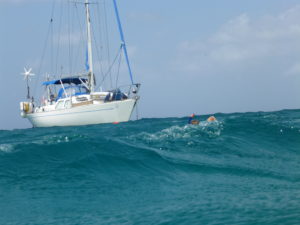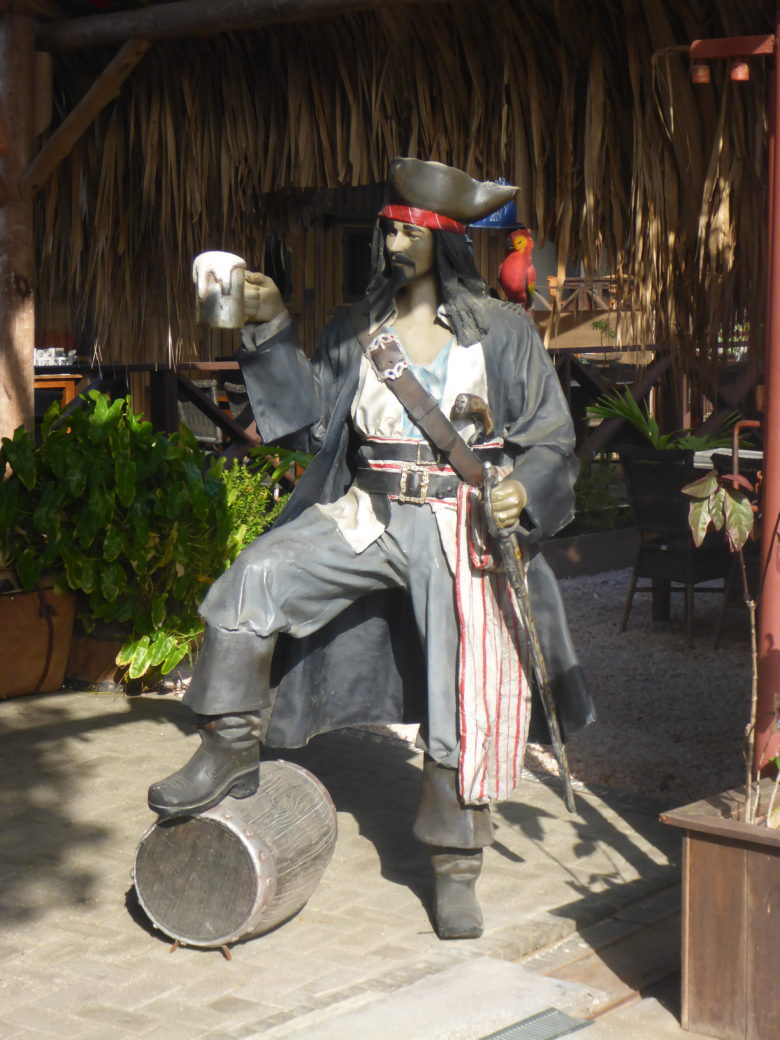12:0483N 68:51.73W
Caracas Bay to Willemstad
Windy Spanish Water and the road to Willemstad.
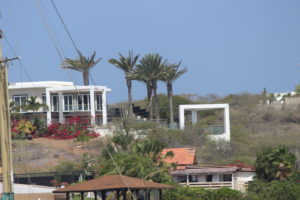
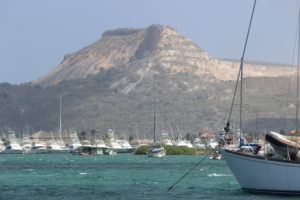
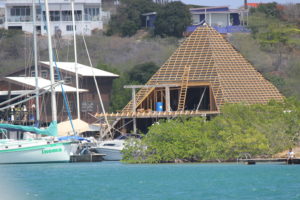
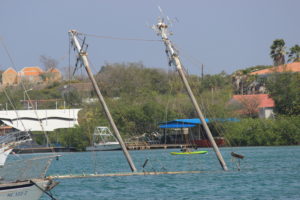
The buses are an interesting mix of public (cheap and air-conditioned but intermittent) and private 9 passenger with all windows open, and expensive vans which are frequent and often pre-booked and take people to and from their own doors. So with a combination of the two we wound our way all around the pretty modest houses and bougainvillea hedges into Willemstad after a couple of days resting and pottering about on Zoonie.
The carnival was in full swing in Willemstad in the afternoon and evenings and the Customs Office in the heart of the historic Punda area was decked out with colourful balloons and masks and all the staff were in that happy ‘Christmas’ mood. “If you want to stay longer, no problem, come back and we will extend your dates”, said the young lass with her pony tail of straightened hair. Her smiling colleague stood behind her and we chatted as she filled in our forms.
Then a long walk over the Queen Emma Pedestrian Pontoon Bridge to the Immigration Office. This 16 pontoon bridge affair, also known as ‘The Swinging Old Lady’, is wide and people stay on it as it swings from the Punda side to the Otrobanda where it is fixed to allow vessels to pass along the busy channel into the bay proper. There is no time table, a man in the engine house on the outer end of the bridge simply fires up the engine when he sees someone coming or receives a radio request. If a big ship is manouvering then it opens for a long time but small vessels squeeze past as soon as there is enough of a gap!
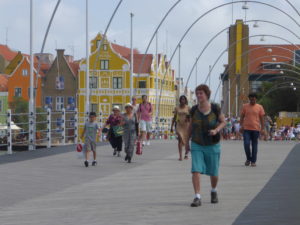
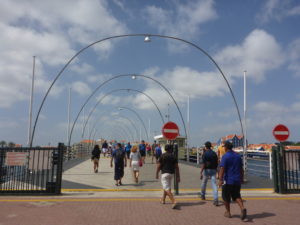
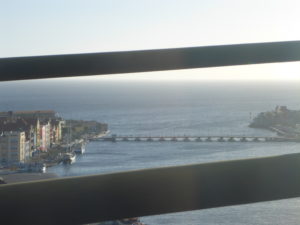
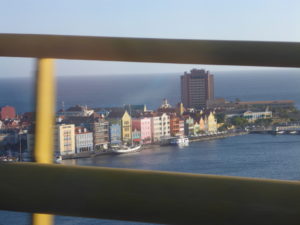
The lady in Immigration had a very severe expression sitting at the window in her featureless, blue-walled office, until all the form filling was done then she was all smiles. Rob asked, tongue in cheek, “You going to the carnival tonight?”
“Oh yes,” she replied with a broad, white toothed smile.
The Harbour Office was closed so we would have to visit them the next day, Monday. We wandered back through the cruise liner dock, passing through the guarded gate where tour operators were fishing for business from the recently arrived liner passengers, and onto a ferry that continues to move people across the channel while the Swinging Old Lady Bridge is open.
By now it was lunchtime and we were hungry so we sat on the quayside at the famous Iguana Bar where people at the back row of tables and chairs wait for diners to leave the front row seats and then dive for their places as the views of river activity, happening just a few metres away, is fascinating. The beer they sold included a good local one they only sell by the pint, never mind, we managed!
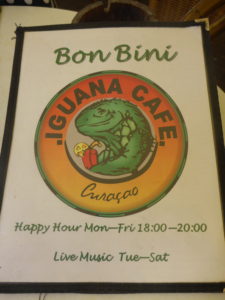
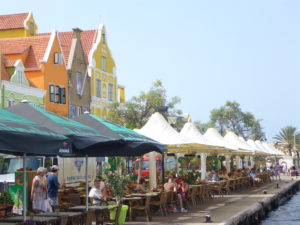
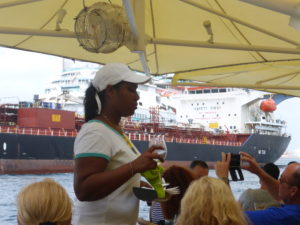
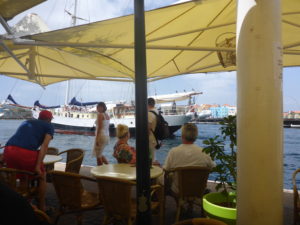
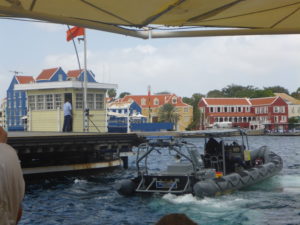
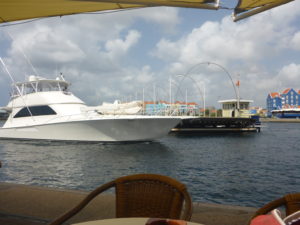
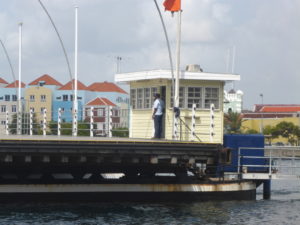
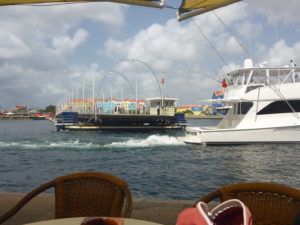
We rounded off our first city day buying fruit and veg at the floating market, so called because ships captains moor alongside to sell their produce, including local goods, fruit and veg, fish and handicrafts, but also goods they have brought from South America and other West Indian islands.
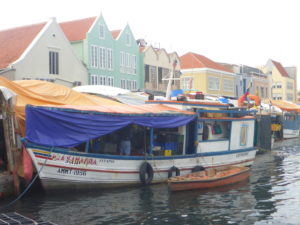
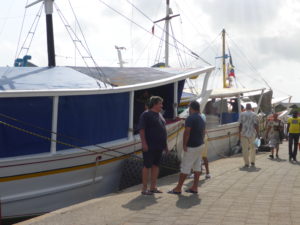
We were ashore early the next day to catch the Harbour Office before they closed at 11.45. The friendly local at the bus stop told us how he had recently inherited some land alongside the road here from his father and his intention is to knock down his single storey home where he lives with his Colombian wife and their son and build a new two storey home and a set of four apartments for rent (each with its own car). “It’s worth 1 million US dollars now,” he said “No wonder the government and local developers tried to get it off me!” Although he was just waiting for a bus to the supermarket he stayed with us as the public bus was late and put us on one of his friend’s passenger wagons.
Back over the bridge to the cheery lady in the Harbour Office who provided our anchor permit for the permitted area we were in already. The government is trying to preserve the coral reefs and seabed around the island so visitors and locals can only anchor in designated areas.
Partly because of the business from the visiting cruise liners and the new wealth brought by Curacao becoming the main crude oil refining centre for the new oil discoveries off the north coast of Venezuela absorbing many of the islands workforce, the shops in Willemstad are of a high standard and we window shopped for a while and then embarked on a real culinary experience.
Plaza Bieu is a food hall with a difference. As you walk in from the sun’s glare it is dark, built of wood and with fat caked colonial roof fans turning the hot humid air. On the left are brick built cooking areas with real charcoal fires and gas burners glowing red and blue hot. On top of them vast saucepans bubble and gurgle with soups and deep fat frying bananas, fish and meat. White rice sits ready for the plate and overworked waiting staff buzz around taking orders and showing people to the wooden picnic benches on the right all covered with colourful waxed table cloths. People of all ages and nationalities pile in to take advantage of the well-earned reputation this place has for excellent food.
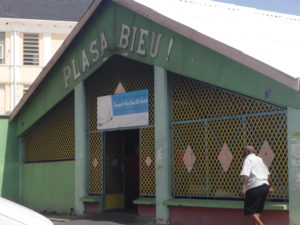
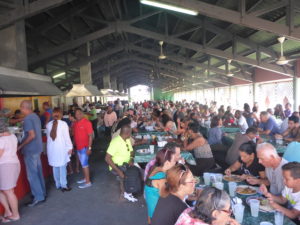
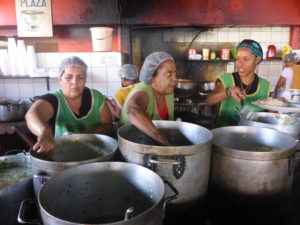
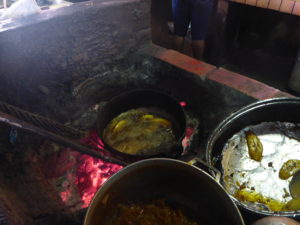
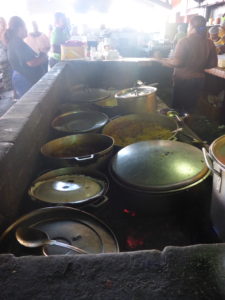
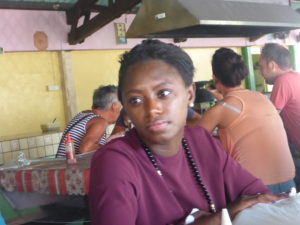
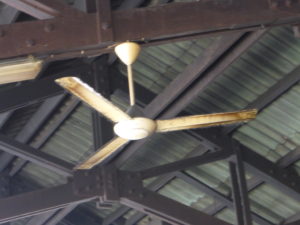
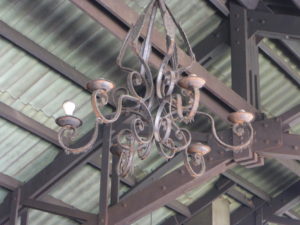
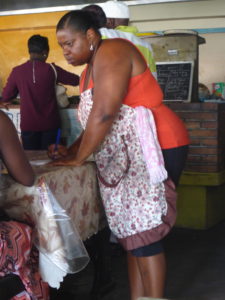
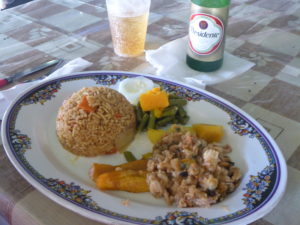
Rob and I shared a plate of fried fish with rice, beans, fried banana and ochre, and vowed we’d be back for more when we return to clear out at Customs etc. On our way to the bus station we sat under the shade of full leafed trees in a little colonial square for a coffee and as we relaxed we noticed the beautiful brightly painted birds clinging in relief to walls, the giant iguanas about to walk around and the smooth chest of the wooden woman in the cleft of the tree trunk. Little did we realise we would see the first two for ourselves ‘in the flesh’ on our ‘car days’.
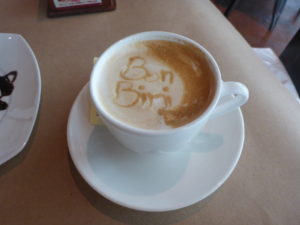
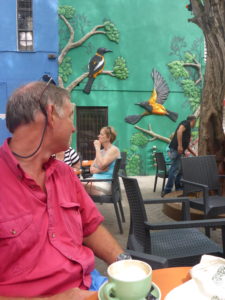
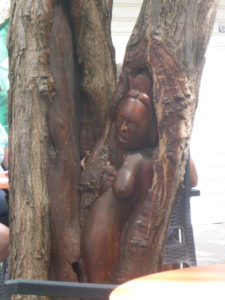
Getting back to Zoonie from the fishermen’s quay was always to be a challenge. Not only were we punching into the strong wind that constantly falls down across the water from the sandstone quarry on Ceru Boca churning up the water into drenching waves, but also the Suzuki outboard is not at all sure of itself having not been used for months. Old fuel has left its residue in the carburettor jets that really need blowing through. By renewing the fuel and running the fuel out of the carburettor instead of turning the motor off has made a difference and it never let us down big time.
That evening we braved the elements and doubtful motor, left Zoonie’s cockpit light on, took the head torch and headed for the Pirate’s Nest bar and restaurant for a meal. Friendly staff, originally from Holland served us with beef and the catch of the day, Red Snapper. All around the fun filled wooden structure pirates of both genders languish in hammocks and stand looking threatening in a plastic sort of way.
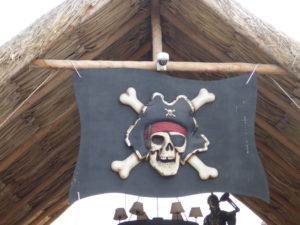
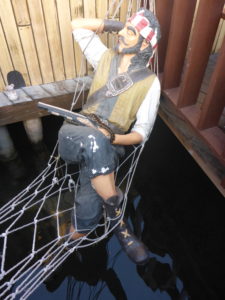
The next day was really windy, so we consoled ourselves with chores on board and the promise of hiring a car for two days which Rob arranged with Budget at the nearby resort of Papagayo.
Two days by car.
After a long hot wait for our hire car pickup we made straight for the Christoffel Mountain Park and on it the Savonet Plantation since we knew that most of the activity starts in the early morning. After 11.00am no one is allowed to climb the mountain on foot as it is too hot and the circuits along concrete roads must be done by car.
As we gained height towards Christoffel Mountain (375 metres) we noticed the changing flora, including lichen or beard moss, and orchids enjoying the moist atmosphere.
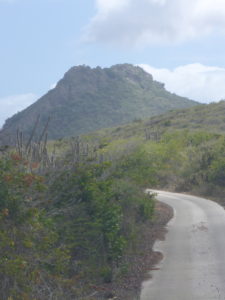
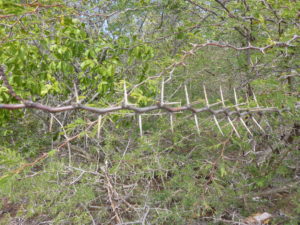
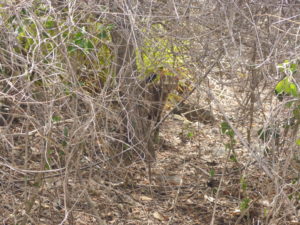
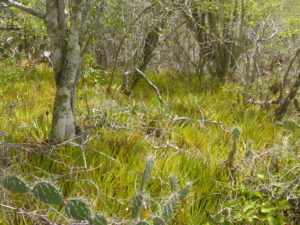
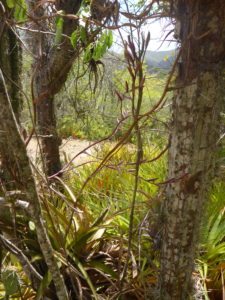
Since it was nearly lunchtime when we arrived we drove to the first car park area in the park to enjoy our picnic at a bench in the shade of a tree. Straightaway lizards started to show an interest in us and a small group gathered around, some braving it and one nipping Rob’s toe to see if it was edible. Then suddenly they all sped away as two golden eagle like birds swooped overhead, also looking for lunch.
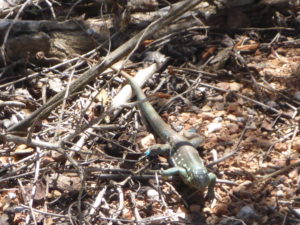
We came across an old master’s mansion, in ruins, a threshing floor, presumably to separate grain from maize kernels, and a round post of mysterious purpose, possibly for beating slaves or grinding meal. The lower region is full of Tamarind and Brazil Trees, both used in the production of dyes for cotton and the columnar cactus known here as kadushi and in the US as Saguaro. The two types that flower year round are visited in the night by bats that pollinate them as they drink the nectar and provide food for many species of birds in the arid dry season.
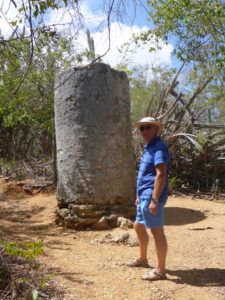
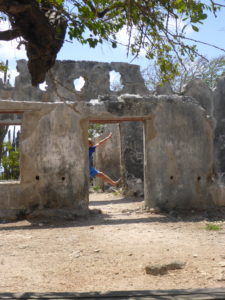
We explored the Savonet Master’s Mansion which is now a museum. Up a near vertical ladder the upper floor comprises two bedrooms with windows on both sides to create a cool draft. The actual wedding bouquet of the master’s bride, dating from 1931 is preserved along with their champagne glasses and photos. It was nearly three in the afternoon and the museum was closing. I could have spent another hour or so there but to Rob’s relief it was time to set off on our second car trail towards the coast.
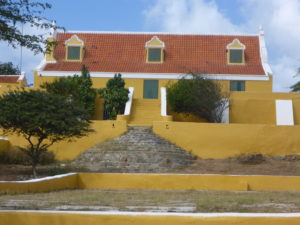
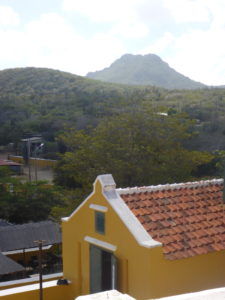
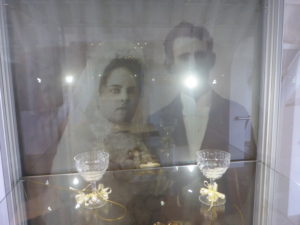
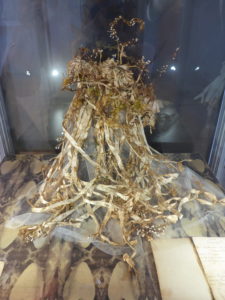
We often heard but did not see tropical mockingbirds and we did see the yellow warbler in numerous places on the island. In the only accessible cave Arawak Indians from South America made their homes 6000 year ago and the cave paintings are reckoned to be around 2000 years old. Then there was the lake, once salt pans, where flamingos graze.
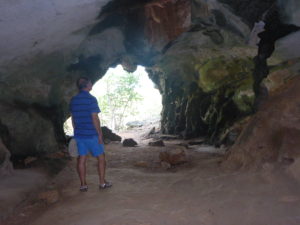
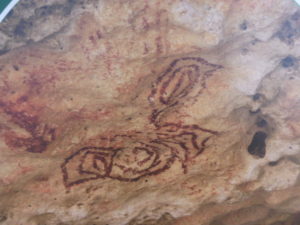
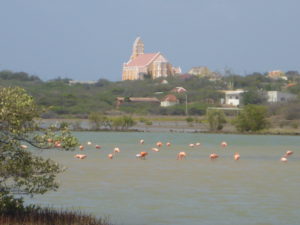
We were at a high look out point, enjoying the view when I had that sneaky feeling we were being watched. Sometimes the best views are just over one’s shoulder like the fine iguana, eyeing us from his thorny bush. A lone hiker shared our enjoyment and said these beautiful reptiles love the heat of the sun to penetrate their scaly skin.
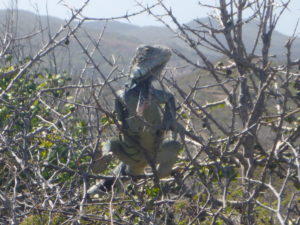
This plantation was one of the most successful on the island, specialising in salt and dyes for export and peanuts, sorghum (Cornflakes), mixed farming and cotton for island use. To overcome aridity a complex layout of wells, where water was drawn up by windmils (many are still in use) into stone troughs or dammed man-made lakes and then used to irrigate the crops.
On our way back we passed the fish-killer tree, (Mata Piska in the Papiamentu language or slave language) whose branches and twigs can be used to drug fishes so they can be caught.
Near to where we are anchored is the restored Fort Beekenburg, built and used mostly by the Dutch East India Company and providing safety and a quarantine base for trading vessels that moored beneath alongside wooden quays that now provide car parking spaces for local fishermen.
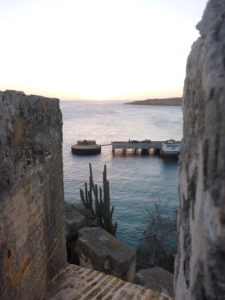
The next morning we sped towards the newly opened Sambil Shopping Mall for what turned out to be a bit of a spree. When Venezuela discovered oil in its northern waters in the 1920s they decided to send it to Curacao for refining. The refinery has brought massive employment to the people and thus wealth to individuals and the government. Also there are always two new cruise liners in Willemstad on a daily basis and lots of luxury resorts along the south west coast. So I guess that’s how they thought a mall on this scale would thrive. We arrived just after opening and found the main doors that appeared on all the posters were not in use. But we did find our way into this shoppers’ haven. I bought some inexpensive clothes, mostly made in Colombia which suit the hot weather (that’s my excuse) and an outfit for Charly and Tom’s forthcoming wedding.
Then we had a delicious coffee before heading off for Lagun Beach, discovered on our way back the day before.
Languishing at Lagun Beach.
Local fishermen were cleaning their catch on tables when we arrived and we kicked ourselves for not buying some fresh red snapper. Cats yowled competitively over the scraps.
We flopped onto two hire loungers to get our bearings, with a cockerel and chicken for company, then went snorkelling all around this tiny, charming bay. There were countless colourful fish, golden eyed tetras with gold lateral lines, big pale blue and green parrot fish with their orange beaks and the Flying Gurnard to name just a few. The latter was mottled stone in colour and we hovered above watching him flush the seabed towards his mouth parts for food. Every now and again he would open his big lateral fins like fans with blue tips, quite beautiful.
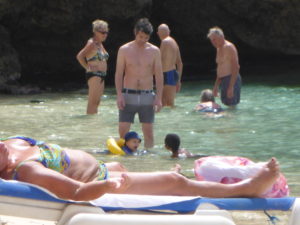
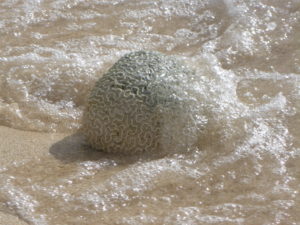
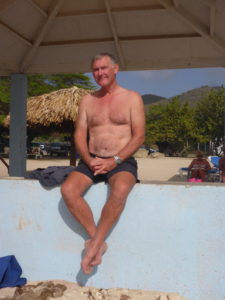
Remember our mystery fish of the Atlantic crossing? It’s an Ocean Triggerfish we discovered from a poster at the bar at the top of the bay. The Gurnard Rob identified on his Tropical fish phone app. Just need an App on Tropical land birds now.
After our picnic lunch we relaxed and then went for another snorkel, the opposite way around and for the first time Rob took the underwater Lumix camera that I use for most of our pics.
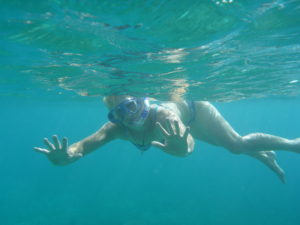
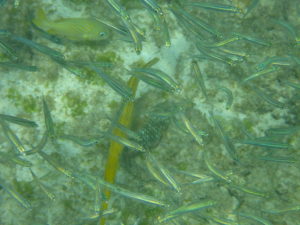
Mr Deckchair man came to collect his money and became a regular visitor on his rounds and we heard his lovely rich laugh at numerous times. He knew some of the local folk and chatted happily in American or Papiamentu (love that word). This bit is for Paul in Oakham. Dutch, Amerenglish (just made that up, cool eh!) and Papiamentu are spoken by the 21 cultures that reside here. The latter developed from Portuguese, Spanish, Dutch and African dialects and became the main form of communication between slaves and their captors.
As the evening approached and wanting to avoid the rush hour from Willemstad towards Spanish Bay, we relaxed at the Bahia Bar on the cliff above the bay along with the iguanas on the wooden floor and in the trees at balcony height around us. A white haired black man in pink swimming shorts crossed himself as he went for an evening swim with his wife and one of those fabulous birds we had seen on the wall while we had coffee in Willemstad, we saw for real, feeding its young.
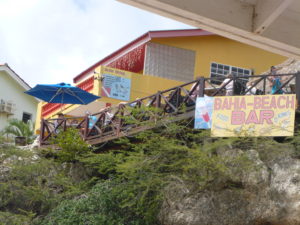
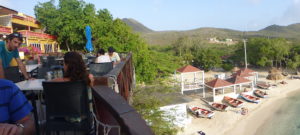
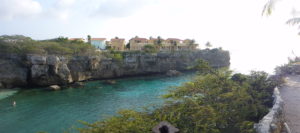
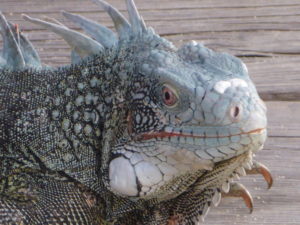
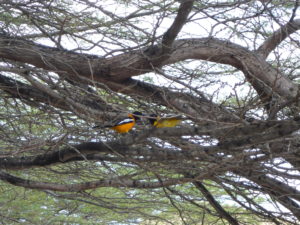
What a beautiful, unspoilt, friendly place.
Forward planning the next passage.
We have made contact with Alessandro Rissi who will be our agent and arrange our transit through the Panama Canal and John Halley who is marina manager of Shelter Bay Marina at Panama, where will stay while the arrangements are being made and we are awaiting our allotted date.
Since our final approach to this lovely island we have witnessed winds that never drop below 25 knots even at night time. Ok, but we wanted to know if they are typical. Locals, officials and John at Shelter Bay have all said the same, it is unusually windy this year. El Nino, is in force, we know that, and will affect our passage planning.
Also off Barranquilla, the estuary to the Magdalena River, there are force 7 winds with mountainous seas, John’s words not mine, that have been raging for weeks as part of the Colombian Low Pressure system. We would have to pass through here on our way to Cartagena if we hoped to visit. John advised against using any mainsail if we chose that route.
At Pirate’s Nest for lunch yesterday we took advantage of their excellent Wi-Fi and really researched the weather between here and Panama over the next couple of weeks. Strong winds are expected in early March each year so to wait would just delay us further by a month or so. Two weather sources showed that on the outer edges of the anti-clockwise spiralling Low the wind reduces to a force four or five and so also does the wave height. You could argue that we had this in the Atlantic, but then the sea had more room to move unlike the shore confined waters off the North coast of Colombia.
So what we have prudently decided is to take a more northern route, to avoid the coastal situation. To sail from here north to around 14’ latitude and then west to a longitude north of Panama and then move south along with the wind and current. It will add maybe 200 miles onto the journey, but we have the time and as delays can happen before canal transits it would not be a bad idea to arrive well in advance rather than allow ourselves to be delayed by the weather.
We plan to clear out tomorrow in Willemstad, then go to Santa Cruz bay at the north west end of the island for a couple of nights before setting off for the 840 mile journey, which will probably take around 8 days.
